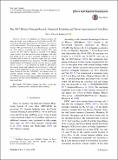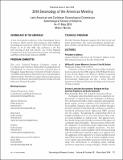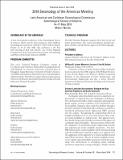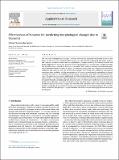| dc.contributor.author | Chacón-Barrantes, Silvia | |
| dc.date.accessioned | 2020-05-07T21:38:16Z | |
| dc.date.available | 2020-05-07T21:38:16Z | |
| dc.date.issued | 2018-03-30 | |
| dc.identifier.issn | 1420-9136 | |
| dc.identifier.uri | http://hdl.handle.net/11056/17323 | |
| dc.description.abstract | An Mw 8.2 earthquake and tsunami occurred off- shore the Pacific coast of Me´xico on 2017-09-08, at 04:49 UTC. Costa Rican tide gauges have registered a total of 21 local, regional and far-field tsunamis. The Quepos gauge registered 12 tsunamis between 1960 and 2014 before it was relocated inside a harbor by late 2014, where it registered two more tsunamis. This paper analyzes the 2017 Me´xico tsunami as recorded by the Quepos gauge. It took 2 h for the tsunami to arrive to Quepos, with a first peak height of 9.35 cm and a maximum amplitude of 18.8 cm occurring about 6 h later. As a decision support tool, this tsunami was modeled for Quepos in real time using ComMIT (Community Model Interface for Tsunami) with the finer grid having a resolu- tion of 1 arcsec (* 30 m). However, the model did not replicate the tsunami record well, probably due to the lack of a finer and more accurate bathymetry. In 2014, the National Tsunami Moni- toring System of Costa Rica (SINAMOT) was created, acting as a national tsunami warning center. The occurrence of the 2017 Me´xico tsunami raised concerns about warning dissemination mechanisms for most coastal communities in Costa Rica, due to its short travel time. | es_ES |
| dc.language.iso | eng | es_ES |
| dc.publisher | Springer | es_ES |
| dc.rights | Acceso restringido | es_ES |
| dc.subject | 2017 México tsunami, Costa Rica, tsunami preparedness, tsunami records, tsunami real-time modeling | es_ES |
| dc.title | The 2017 México Tsunami Record, Numerical Modeling and Threat Assessment in Costa Rica | es_ES |
| dc.type | http://purl.org/coar/resource_type/c_6501 | es_ES |
| dc.description.procedence | SINAMOT | es_ES |
| dc.identifier.doi | https://doi.org/10.1007/s00024-018-1852-7 | |




